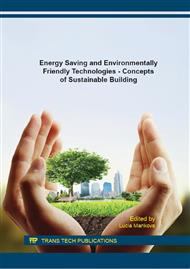p.445
p.453
p.461
p.469
p.477
p.485
p.493
p.503
p.511
Obtainable Method of Measuring the Solar Radiant Flux Based on Silicone Photodiode Element
Abstract:
Solar radiation exposure and its monitoring does have not only the importance for climate science and meteorology however is equally of highly relevant use for the field of Building Science as primarily those of analyzing thermal aspects in building physics. Here the measuring of solar irradiance by means of well-established solar instruments can be applied whose advances have been undergoing steep progress. Currently, a silicon photodiode element, as a truly obtainable form, may have a feasible exploitation in the field of building applications concerning the solar radiant flux quantifying. It represents a small optoelectronic element and has a several exploitable advantages. The paper presents a perspective alternative to monitor solar irradiance. Own measurement assembly is proposed and introduced. Initial in-situ measurements are performed and final comparability with existing commercial solar instruments is presented. An obtained correlation with existing types demonstrates its applicability to the field of building science and solar energy.
Info:
Periodical:
Pages:
477-484
Citation:
Online since:
January 2016
Authors:
Keywords:
Price:
Сopyright:
© 2016 Trans Tech Publications Ltd. All Rights Reserved
Share:
Citation:


